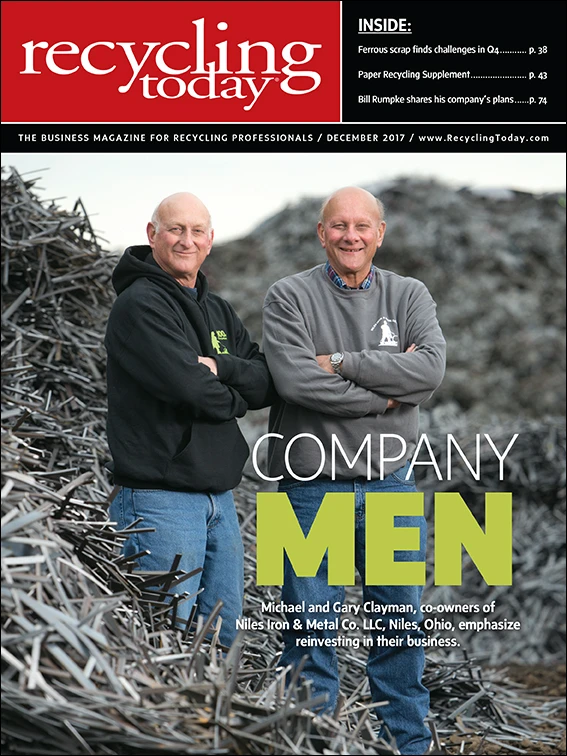After an October price drop, ferrous scrap prices held steady in November (though with regional disparities) as electric arc furnace (EAF) steelmakers and scrap processors alike aim to book a fourth quarter that will not eat into what for many has been a profitable year.
In the Midwest, prices held steady in the early November buying period, according to indices published by American Metal Market (AMM). None of the three major grades moved by more than $5 per ton in price per AMM’s Midwest indices for November.

The publication’s reporting on its index pricing, however, indicates that mills in many other parts of the country bought scrap in early November for some $10 per ton less than in October.
Mills in the Chicago region ran counter to that trend, according to AMM, holding steady on scrap prices in November compared with October.
Following the October drop, some recyclers expressed optimism that prices would bounce back in November. Unexpected steadiness in supply, however, seems to have dashed that hope.
“We have not seen a slowdown at all,” says one Great Lakes region processor regarding supply. “October flows on prime grades (bush/clip) were up 12 percent, and November looks like it should hit its monthly average for us.”
Vehicles destroyed by late summer and early fall hurricanes in the South have played a role in the steady scrap supply as automakers and their first-tier suppliers have ramped up production to replace as many as 750,000 destroyed vehicles. Those cars and trucks likely were replaced as soon as insured motorists had
Despite the ferrous scrap price drop, construction and demolition work has continued apace in the Great Lakes region, according to the same recycler. “In our

Looking ahead to the closing weeks of 2017, a recycler in the Southeast predicts a stable market, at least until a new wall calendar is in place. “The market is a solid sideways from October, and I don’t expect much to change in December. It will be interesting to see how January pans out, though,” he comments.
Steelmakers in the United States are on track to operate at nearly a 75 percent mill capacity rate in 2017, up from closer to 70 percent in 2016.
Figures maintained by the Washington-based American Iron & Steel Institute (AISI) show U.S. steel output for the week ending Nov. 11, 2017, was 1.74 million tons, up by 9.3 percent compared with the 1.59 million tons produced in the comparable week in 2016. The mill capacity rate for that week in 2017 was 74.6 percent compared with 67.1 percent for the same week of 2016.
Production for the second week of November 2017 also was up 1.4 percent from the previous week, ending Nov. 4, 2017, when the mill capacity rate was at 73.6 percent.
Year-to-date output through Nov. 11, 2017, was 78.2 million tons at a 74.6 percent annual average capacity rate. Total output is up 4 percent from the 75.1 million tons produced through that time in 2016
Many EAF steelmakers, through the first three quarters of 2017, have released profitable financial statements, and the CEO of one of the newest EAF companies said his firm is gaining traction by focusing on sales and operations rather than worrying about overcapacity in China.
At an AMM steel industry conference in mid-November, the CEO of Osceola, Arkansas-based Big River Steel said his firm is attracting new orders while others are “out harping about the Chinese needing to cut their capacity in half.”
Regarding U.S. steelmaking, AMM reports Big River CEO David Stickler as having said, “If you do it right, you can make a heck of a lot of money.”
Many of the companies that may not be doing it right, Stickler said, have not invested in new steelmaking technology in several decades.
“In our area there is a fair amount of demo projects going on: bridge repairs and replacements along with renovation projects. Business is good.” – a Great Lakes region recycler
The nation’s largest EAF steelmaker, Charlotte, North Carolina-based Nucor Corp., has demonstrated profitability through the first three quarters of 2017, with its net income up by 48.8 percent compared with the same time frame in 2016.
Its mills have grown from earning $1.4 billion in the first
Nucor’s raw materials operations also include its Nucor Steel Louisiana direct-reduced iron (DRI) facility. This segment’s performance declined in the third quarter of 2017 compared with that period in 2016 as the DRI facility experienced unplanned outages for most of the quarter, Nucor indicates in comments that accompanied its third quarter 2017 results.

Explore the December 2017 Issue
Check out more from this issue and find your next story to read.
Latest from Recycling Today
- Athens Services terminates contract with San Marino, California
- Partners develop specialty response vehicles for LIB fires
- Sonoco cites OCC shortage for price hike in Europe
- British Steel mill’s future up in the air
- Tomra applies GAINnext AI technology to upgrade wrought aluminum scrap
- Redwood Materials partners with Isuzu Commercial Truck
- The push for more supply
- ReMA PSI Chapter adds 7 members





